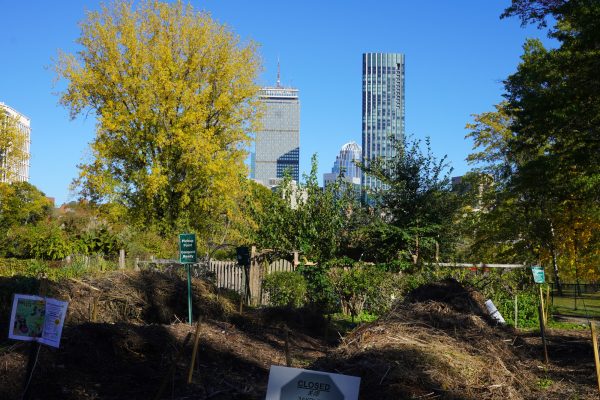From planting trees to topping bus shelters with green roofs, both city-led and volunteer-run organizations are taking strides to make Boston greener.

The city’s Green New Deal, kickstarted in 2021, has launched a series of policies and programs aimed at fast-tracking decarbonization, building climate resilience and funding public transportation.
“Fundamentally, this is not just about climate,” said Hessann Farooqi, co-coordinator of the Green New Deal Coalition and executive director of the Boston Climate Action Network. “This is about reducing bills and improving the comfort and quality of life for our residents.”
City-wide programs and policies, including Boston Community Choice Electricity and the Building Emissions Reduction and Disclosure Ordinance, are striving to improve energy efficiency across Boston.
Boston Community Choice Electricity allows the City to purchase renewable energy on behalf of residents at a rate of their choice, ensuring they are supplied energy “at a lower rate that stays lower for longer,” Farooqi said.
The program, now in its fourth year, has saved residents between $200 and $700 a year on their energy bills, Farooqi said.
“The city is now one of the largest renewable energy purchasers in all of New England,” Farooqi said.
Building Emissions Reduction and Disclosure Ordinance, or BERDO, establishes requirements for large buildings to slash their greenhouse gas emissions, aiding the city in its goal to reach net-zero emissions by 2050.
The ordinance enforces penalties when buildings don’t meet established standards and requires landlords to repair their buildings, which improves “day-to-day quality of life” for tenants while reducing emissions, Farooqi said.
“It is the single most important, most impactful law that we have on the books to address the climate crisis from city government,” Farooqi said.
Farooqi said around 70% of Boston’s greenhouse gas emissions come from its buildings and half of the city’s total emissions come from its largest buildings.
Buildings that BERDO regulates are responsible for approximately 40% of Boston’s total emissions, according to Aidan Callan, BERDO program manager, who wrote in an email to the Daily Free Press.
While building owners have had some difficulty navigating the logistics of BERDO compliance, the City is committed to educating property managers and providing direct technical support, wrote Callan.
The city has also targeted public transit in their mission to tackle climate resilience.
Under the Green New Deal, green roofs sprouting drought-resistant plants were installed at 30 bus stations lining the MBTA 28 Bus route last year. The roofs provide shade, improve air quality and stormwater retention and benefit local wildlife, such as birds and pollinators.
In 2022, the City also eliminated fares for the 23, 28 and 29 buses through March 2026.
“More residents than ever get to work or to school on buses that are fast and free,” Farooqi said. “Rider satisfaction is up, and driver satisfaction is up.”
As city-led initiatives continue to take form, community organizations are working to address climate resilience issues in their neighborhoods.
Tree Eastie, a volunteer-driven tree planting initiative founded in 2019, is focused on expanding tree coverage in East Boston, which has the lowest tree canopy coverage of any neighborhood in Boston.
“We plant trees, we maintain and nurture the trees that have already been planted and then we educate residents on the benefits the trees provide to get them to want to support our mission,” said Bill Masterson, Tree Eastie’s founder and executive director.
Tree Eastie has planted 676 trees in East Boston since it planted its first tree four years ago, and he expects to have planted 700 by the end of the year, Masterson said.
“We’re planting trees in people’s yards. We’re planting in parks, on streets, cemeteries, school yards, wherever we find the space,” Masterson said.
The average tree coverage rate in Boston is 27%. East Boston has just 7% canopy coverage.
Masterson added that Boston Logan Airport is a significant source of noise and air pollution.
“Logan Airport is in our backyard,” said Masterson. “There’s a lot of environmental factors that we’re up against.”
Historically redlined districts, such as East Boston, tend to be subject to substantial environmental inequities, said Joelle Renstrom, a senior lecturer of rhetoric at Boston University who teaches a course about environmental justice and urban tree canopies.
“It is a concentrated, systemic effort between community leaders and banks and all of these institutions to make certain desirable areas to live absolutely inaccessible to people of color,” Renstrom said. “People of color get shunted into certain neighborhoods that are not super great.”
Areas lacking tree coverage are typically more at risk when dangerously hot temperatures arise.
It is “deeply challenging” to fix environmental issues without first addressing the inequalities stemming from historic redlining, said Renstrom.
Carlos Garcia, a community outreach organizer for Tree Eastie, said the organization is making efforts to garner more public interest in tree planting.
“Tree Eastie is developing in its plans to become an educational organization, along with doing the heavy lifting of picking trees and getting work done on the ground,” Garcia said.
Farooqi emphasized the importance of being educated on how elected officials impact climate resilience efforts, especially ahead of next month’s city-wide elections and next year’s state-level elections.
“We have a lot of work to do at the state level in terms of climate and environmental justice,” he said.